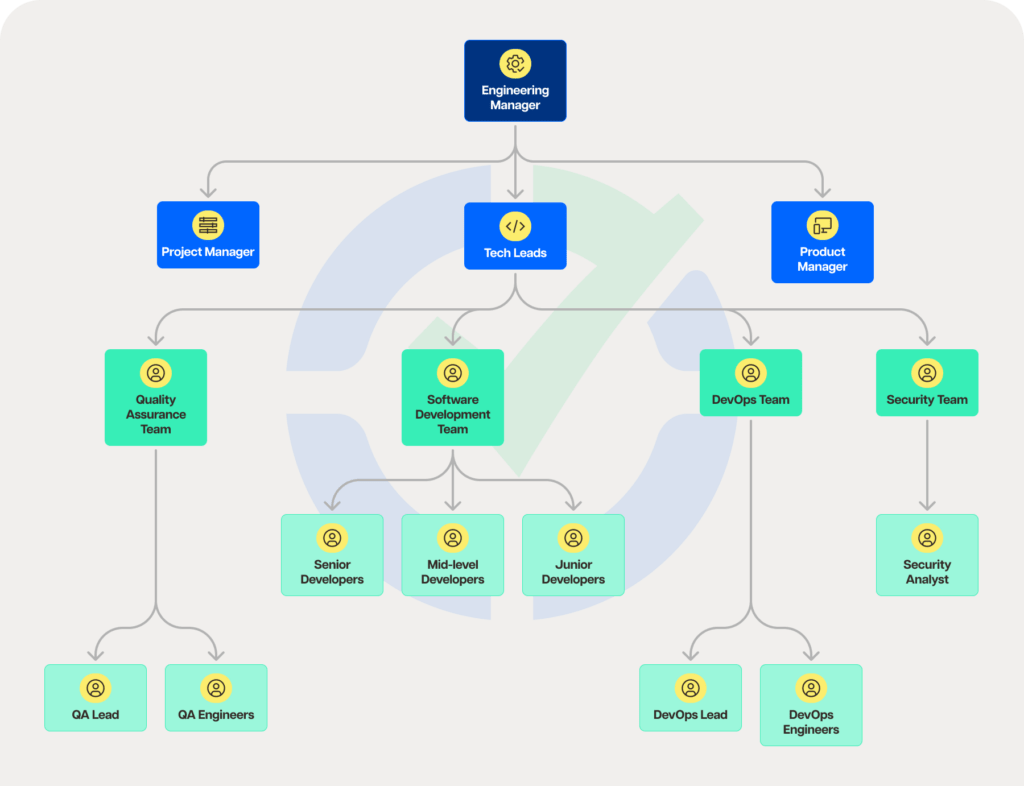The success of a firm can be determined by the efficacy of its engineering team structure in the ever-changing realm of technology. It’s not just about putting together a team of gifted people; it’s about composing a symphony in which every player contributes vitally while maintaining harmony with the others. This blog explores the complexities of creating an effective engineering team organization, including its significance, essential elements, guiding concepts, and useful tactics.
Table of Contents
- Importance of an efficient engineering team structure
- Key components of an engineering team structure
- Sample engineering team structure
- Principles of an effective team structure
- Crafting your engineering team
- Navigating challenges and finding solutions
Importance of an efficient engineering team structure
Effective engineering team structures are essential for high output, creative problem-solving, and project success. It makes jobs more clear, encourages teamwork, and makes sure the correct people are put to work where they are most needed. Additionally, it fosters an atmosphere in which people flourish and give their all to achieve group objectives.

Key components of an engineering team structure
- Leadership roles: Engineering Manager overseeing the department, along with Tech Leads providing guidance and mentorship.
- Core development roles: Including Senior, Mid-level, and Junior Developers, each contributing to different aspects of system design and development.
- Specialized roles: Such as QA Engineers ensuring product quality, DevOps Engineers managing deployment pipelines, and Security Analysts fortifying system integrity.
- Support roles: Project Managers and Product Managers facilitating communication and alignment between the engineering team and other departments.
Sample engineering team structure
- Small to medium-sized team structure
- Engineering Manager
- Tech Leads
- Software Development Team
- Quality Assurance Team
- DevOps Team
- Security Team
- Project Manager
- Product Manager
- Tech Leads
- Engineering Manager
- Large team structure
- Similar to the small to medium-sized structure but with potentially more layers of hierarchy and specialization to manage complexity.
- Distributed or remote team structure
- Adaptations to facilitate effective communication and collaboration across geographical boundaries, leveraging remote work tools and practices.

Principles of an effective team structure
- Role and responsibility clarity: It is crucial to make sure that each member of the team fully comprehends their unique contributions and how these fit in with the overall goals of the organization. Within the team, a clear understanding of roles and responsibilities promotes accountability and a sense of ownership.
- Skill set balance: It’s critical to strike a careful balance between a deep mastery of several fields and specialized knowledge. By recognizing the interdependencies both inside the team and throughout the company, this balance enables team members to cooperate across functions with ease, utilizing their own talents.
- Promotion of cross-functional collaboration: It is essential to actively encourage communication and cooperation between various teams and roles. By fostering exchanges of ideas, insights, and views, organizations may leverage the collective intelligence of their workforce to drive creativity and problem-solving capacities to unprecedented levels.
- Scalability and adaptability: Creating a flexible and scalable team structure is essential for negotiating the ever-changing business environment. The structure must be able to support expansion and fluidly adjust to changing needs without sacrificing coherence or efficiency as organizations change and project requirements change.
Crafting your engineering team
- Assessment of organizational needs: Begin by comprehensively understanding the current challenges and future aspirations of the organization. This involves identifying the specific skill sets necessary to overcome existing hurdles and achieve long-term goals. By aligning team composition with organizational objectives, you can ensure that every member contributes meaningfully towards the collective vision.
- Formation of a core team: Establishing a solid foundation is essential for the success of any engineering team. Start by assembling a core team comprising individuals who possess the requisite expertise and competencies to address immediate requirements. As projects evolve and new challenges emerge, gradually expand the team to accommodate specialized roles, thereby enhancing its overall effectiveness and resilience.
- Commitment to continuous improvement: The journey towards an optimized engineering team structure is an ongoing process. Regularly evaluate the efficacy of the existing structure, identifying areas for improvement and adaptation. By embracing a culture of continuous learning and refinement, teams can proactively address inefficiencies and seize opportunities for innovation, thereby maximizing performance and driving sustainable growth.

Navigating challenges and finding solutions
Identifying common pitfalls
Identifying and dealing with the typical problems that can undermine an engineering team’s efficacy is critical. These could include the tendency to overcomplicate hierarchies, undervalue the significance of open lines of communication, or disregard the need for positions that are specifically adapted to particular tasks or projects.
Implementing strategies
Organizations can give transparency in communication channels and decision-making procedures a top priority to overcome these obstacles. Encouraging a culture of open communication and cooperation creates a space where team members feel comfortable sharing their thoughts and worries, which improves problem-solving and decision-making.
Furthermore, funding continuous professional development programs guarantees that team members have the knowledge and abilities to adjust to changing project requirements and technological breakthroughs. Organizations can avoid typical errors and promote a more robust and agile engineering team structure by adopting these tactics.
Conclusion
The importance of a well-designed engineering team structure cannot be emphasized enough. It acts as the support structure for the advancement of technology and the achievement of corporate objectives.
Businesses can develop teams that are productive, flexible, and adaptable in the face of changing obstacles by comprehending the essential elements, upholding basic values, and utilizing strategic design techniques.
Recall that the best kind of structure is the one that is customized to your organization’s particular requirements and goals.

Andy is a technology & marketing leader who has delivered award-winning and world-first experiences.


